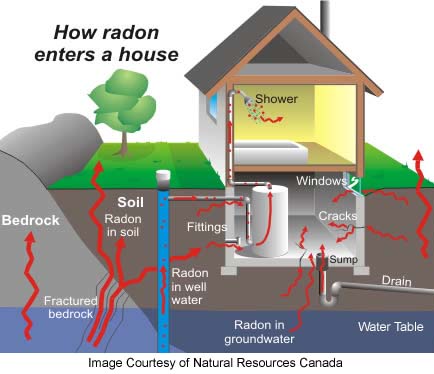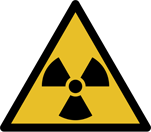Surgeon General of the United States Health Advisory:
"Indoor radon gas is a national health problem. Radon causes thousands of deaths each year. Millions of homes have elevated radon levels. Most homes should be tested for radon. When elevated levels are confirmed, the problem should be corrected."
The following was taken from the Kansas University National Radon Program Services site...
What is radon?
Radon is a radioactive gas. It is colorless, odorless, tasteless, and chemically inert. Unless you test for it, there is no way of telling how much is present.
Radon is formed by the natural radioactive decay of uranium in rock, soil, and water. Naturally existing, low levels of uranium occur widely in Earth's crust. It can be found in all 50 states. Once produced, radon moves through the ground to the air above. Some remains below the surface and dissolves in water that collects and flows under the ground's surface.
Radon has a half-life of about four days—half of a given quantity of it breaks down every four days. When radon undergoes radioactive decay, it emits ionizing radiation in the form of alpha particles. It also produces short-lived decay products, often called progeny or daughters, some of which are also radioactive.
Unlike radon, the progeny are not gases and can easily attach to dust and other particles. Those particles can be transported by air and can also be breathed.
The decay of progeny continues until stable, non-radioactive progeny are formed. At each step in the decay process, radiation is released.
Sometimes, the term radon is used in a broad sense, referring to radon and its radioactive progeny all at once. When testing measures radiation from the progeny, rather than radon itself, the measurements are usually expressed in working level (WL) units. When radiation from radon is measured directly, the amount is usually expressed in picocuries per liter of air (pCi/L).
What is the "acceptable" level of radon in air?
The EPA states that any radon exposure carries some risk; no level of radon exposure is always safe. However, the EPA recommends homes be fixed if an occupant's long-term exposure will average 4 picocuries per liter (pCi/L) or higher.
What is a "picocurie" (pCi)?
A pCi is a measure of the rate of radioactive decay of radon. One pCi is one trillionth of a Curie, 0.037 disintegrations per second, or 2.22 disintegrations per minute. Therefore, at 4 pCi/L (picocuries per liter, the EPA's recommended action level), there will be approximately 12,672 radioactive disintegrations in one liter of air during a 24-hour period.
What is a "working level" (WL)?
Some devices measure radiation from radon decay products, rather than radiation coming directly from radon. Measurements from these devices are often expressed as WL. As noted above, conversions from WL to pCi/L are usually approximate. A level of 0.02 WL is usually equal to about 4 pCi/L in a typical home.
If a working level (WL) value is converted to a radon level (pCi/L), the conversion is usually approximate and is based on a 50 percent equilibrium ratio. If the actual equilibrium ratio is determined (which is rare), it should be stated. The 50 percent ratio is typical of the home environment, but any indoor environment may have a different and varying relationship between radon and its decay products.
Why is 4 pCi/L the recommended action level for Radon?
EPA recommended this mitigation action level in 1986 for several reasons. First, at lower levels (2 pCi/L) measurement devices' false negative errors increase threefold, and false positive errors increase twofold. Secondly, mitigation research indicates that elevated levels can be reduced to 4 pCi/L or less 95% of the time. Research shows that 2 pCi/L can be achieved 70% of the time. Further, today's mitigation technology can reduce radon levels to between 2 and 4 pCi/L most of the time. Finally, cost benefit analysis performed in 1986 indicate that an action level of 4 pCi/L results in a cost of about $700,000 per lung cancer death saved. If the action level was set at 3 pCi/L, the cost would be $1.7 million, and if set at 2 pCi/L, the cost would be $2.4 million per lung cancer death saved. EPA states that 4 pCi/L is a recommended action level, yet homeowners can further reduce their potential lung cancer risk by mitigating homes that are below 4 pCi/L.
Click here to go to the Kansas University Radon Fact Sheet page or here to view some of our actual reports.


